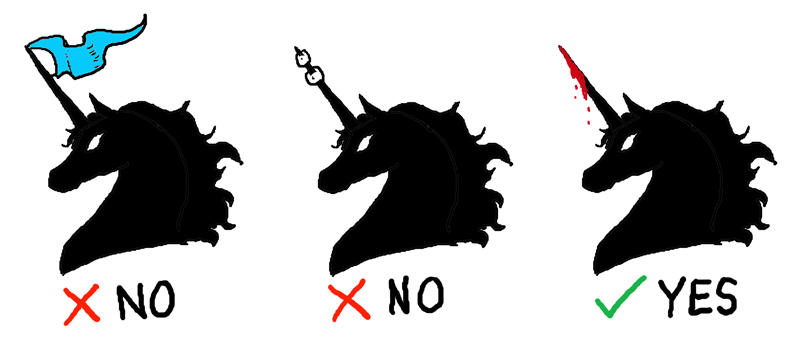Let’s have a little talk about tweedle beetles unicorns.
So. Okay. I like unicorns. I’m not ashamed to admit it. In third grade, I was so into unicorns that I may or may not have formed an imaginary religion centered around them. I’m much more restrained about my love for unicorns now that I’m (allegedly) a grownup, but I still think they’re pretty cool.
But here’s the problem. A lot of the people making unicorn-related things (movies, stickers, etc) do not get what is cool about unicorns.
Even when I was a kid, sometimes family members who heard I liked unicorns would get me something with a unicorn on it that looked like this:
People. People. That is not a unicorn. That is... I don’t even know. A pig with a really big zit.
The great thing about unicorns is this: they are like horses, only armed for violence.
Unicorns are the original eco-terrorists. They’re badass, mystical defenders of the forest. They can melt into the woods like a ninja, wield powerful magic, and have a big impaling spike on their heads for melee combat. Everything about them screams “do not mess with me.”
And yet in books, games, and movies, 99% of the time they exist just to be captured, killed, or corrupted by bad guys. They’re worse than princesses.
The best (by which I mean most ironic) part is that there is always some talk about how powerful or elusive unicorns are supposed to be and how it must have taken a truly potent evil to do this awful thing.
Dude. What self-respecting bad-guy hasn’t? Darkness... Voldemort... King Haggard... it’s like the initiation rite for the Cool Kids Club of Evil.
And mind you, this happens in books and movies that I absolutely love. But seriously, guys, we need more positive unicorn role models, here. We do have a few Princess Leias of the unicorn world — like, the Last Unicorn was definitely badass; and despite being purple, Twilight Sparkle doesn't back down from a fight... but they're the exceptions that prove the rule. We need more Sarah Connor/Katniss Everdeen kind of unicorns. They have so much badass guerrilla warrior potential!
I mean, look at that horn. What do you think it's for? It's not for butting heads in courtship displays. It's not for picking up radio signals. It’s for FATAL STABBING.
Unicorns are lethal murder ponies.
It’s time to start treating them like it.
And what have we learned today?
Horrible murderers are the snuggliest!












































